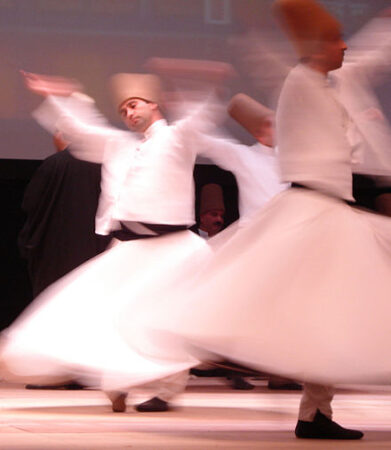
Whirling Dervish from Wikimedia by carlosLG2007
Many of us start our day with the dark caffeinated brew once called the drink of the devil. Even non-drinkers often love the familiar scent of brewing coffee. Long, long ago, our history with this addictive bean started with a goat, or so the story goes. A young Ethiopian goat herder named Kaldi noticed one day that his best goat was dancing like a maniac while bleating with excitement. It turns out that the goat was eating the berries of a certain plant and Kaldi, upon eating a few, began dancing himself. This drew the attention of a holy man passing by who was also fascinated by the berries and took some home. Upon experimenting with the beans, he found that when he fed them to his disciples, they were able to stay up all night to listen to his sermons where they had previously had trouble staying awake. Thanks to its stimulating effects, the prophet went from tedious to electrifying in reputation. Coffee has also been used to add zest to the mystical dances of Sufi whirling dervishes.
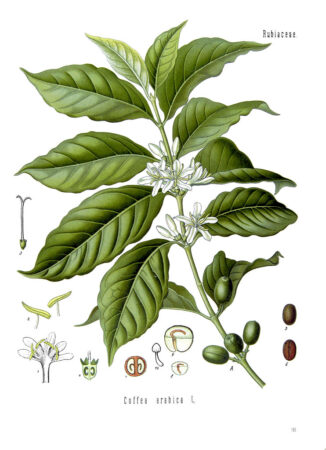
Coffea arabica Botanical art Wikimedia Public Domain
The mountains of Ethiopia are the origin of some of the finest coffee where people still pay homage to the delicious brew through a long tradition of the coffee ceremony. Integral to cultural and social life, the ceremony is a mark of Ethiopian hospitality. From the port of Mocha in Yemen in the early 16th century coffee spread through the Islamic world by way of Red Sea trade routes. As with so many precious commodities, coffee plants were closely guarded, and the seeds were often boiled or roasted quickly so they could not grow if smuggled out of the area. However, holy man Baba Budan, on a pilgrimage to Mecca, managed to find some seeds of this magic plant and kept seven, a sacred number in Islam, to smuggle out to India. Some say he hid the seeds in his lush beard, some say he taped them to his stomach, however he did it, coffee plantations around the world were seeded by his efforts.
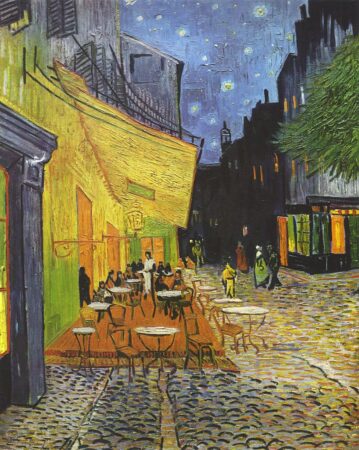
Vincent van Gogh Café Terrace at Night Wikimedia Public Domain
Coffee became very popular in Constantinople by mid-1500s where several hundred coffee houses had been established. Next step for the craze was Europe, and by the 17th century coffee houses were numerous, especially in England, France, and Holland. As a place of socialization and exchange of ideas, such cafes were a threat to old ideas and institution spurring some government attempts to ban coffee and coffee houses for fear of revolutionary ideas. Energized aficionados protested, government backed down, and coffee houses remained throughout the Muslim world and in Europe. From Turkey to Vienna and finally London, coffee houses sprung up by the thousands and continued to be gathering places where people drank the bitter, addictive brew and shared ideas on politics and current events. In addition to being a social lubricant, some saw the potential for medical treatment. In a book titled The Natural History of Coffee, Thee, Chocolate, and Tobacco printed in London in 1682 the author Christopher Wilkinson tells the story of a certain Dr. Willis who recommended the drink for people with headaches, dizziness, lethargies, and congestion—symptoms of an overall cold constitution—and sent them to coffee houses to warm up their temperament. However, he also cautions men that it may “slacken their strings, as they become unfit for the sports, and exercises of the Bed, and their Wives recreations….”
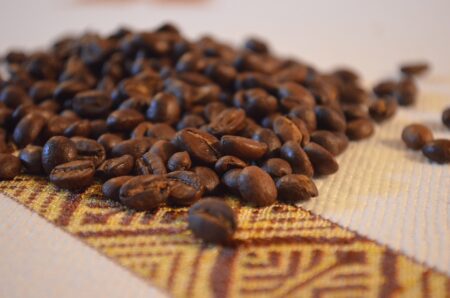
Ethiopian Coffee Beans Wikimedia Public Domain
The dark drink continued to be cast as evil but remained extremely popular. The story is told that Pope Clement VIII in about 1600 conducted a taste test and declared This Satan’s drink is so delicious that it would be a pity to let the infidels have exclusive use of it and subsequently baptized some beans to remove the influence of the devil. In 1675 King Charles II of England decreed that coffee houses should be suppressed, and banned the selling of coffee, chocolate, sherbet, or tea—a proclamation that did not last long, government again underestimating the energy of passionate coffee drinkers. London in the late 17th century was a center of commerce and many merchants gathered in coffee shops to do business and share information, including near the wharves, where Edward Lloyd opened one in 1663. The trade of shipping information at the shop was a foundation for the establishment of Lloyd’s of London. Other such cafes were once known as ‘penny universities’ in England because people of all classes could gather for the news and to read books for just a penny, the price of a cup of coffee.
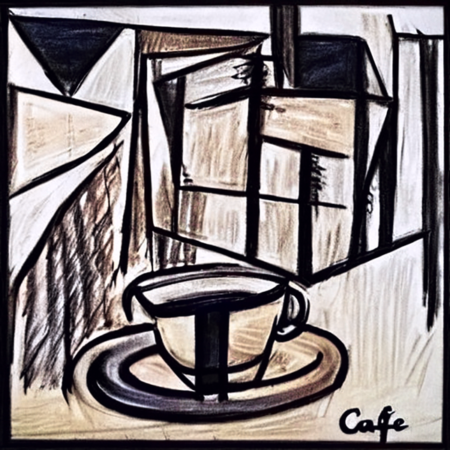
The Café from Wikimedia by David Soriano
What about the bean and the brew? From citrus to chocolate and earthy to floral, everyone has a favorite. It’s all in the origin and the roasting. There is a definite terroir to the flavor of coffee with geography, season, and local processing affecting the taste and aroma profile. But roasting is what creates the hundreds of coffee flavor compounds from caramelization of sugars in the fruit to the cracking of the dry bean where aromatic compounds are released and beans readied for roasting. At which point, roasters may blend different beans and vary timing to produce products from light to dark with characteristic flavor and aroma characteristics.
As a product of the earth, coffee can be grounding and settle emotions, getting rid of negative energy and, as ancient Sufis found, stimulating the mind to concentrate. Perhaps so many people drink it in the morning and at work because, in addition to waking you up, it helps with motivation to get things done. In the Middle East coffee has a special significance in expressing generosity and hospitality. It is considered a ceremonial act of generosity, where it is traditionally prepared in front of guests. Mostly, throughout history, it has been an important part of social gatherings, a center for thought and entertainment, and a part of our global history.
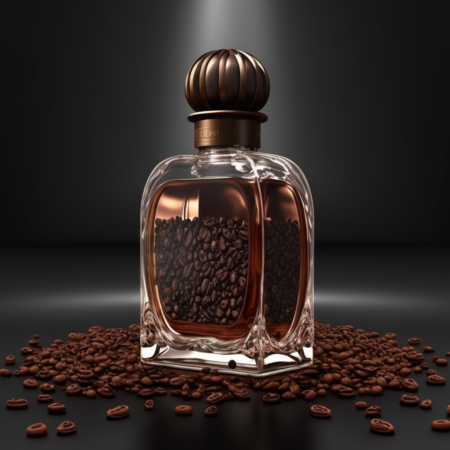
Mid Journey Coffee and flacon by Emmanuelle
In perfumery, the extract mainly provides a familiar coffee note that with overtones that may be sweet and creamy, perhaps also nutty or wheaty, but always comforting and familiar. Recently, the flower has begun to be extracted for scent and is described as being ethereal and spicy floral with notes of chocolate and jasmine.
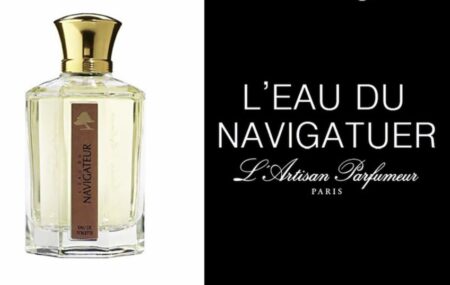
L’Artisan Parfumeur L’Eau du Navigateur courtesy of the brand
From Fragrances of the World, we learn that “The first fragrance in Michael Edwards’ database to use coffee is L’Artisan Parfumeur L’Eau du Navigateur (1978). Master perfumer Jean-Claude Ellena used spices with an overdose of coffee and masculine woody notes. Coffee notes in perfumery weren’t common before the 1990s. Did the popularity of gourmand notes that followed Mugler’s Angel have some role to play in coffee’s rise? Coincidentally, the next prominent name in the timeline of coffee fragrances is Mugler’s A*Men (1996). Through this decade coffee was often cast as a masculine gourmand note. Columbian coffee beans were used in the cult men’s fragrance by Balenciaga, Cristobal Pour Homme (2000) and DKNY Be Delicious Men (2005) paired green apple with coffee and woody notes. Western Niche brands also embraced coffee – Comme des Garçons Series 7 Sweet, Jo Malone London Black Vetyver Café, Bond No. 9, So New York are just a few.”
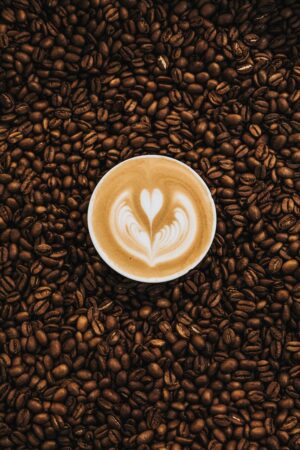
Unsplash
American artisan perfumer Michael Schrammel believes coffee has gained such traction in perfumery because it’s a note so many people can relate to. “Coffee is something most of us smell every day that it’s become that it’s become almost grounding comforting and warming. It’s a note that can be blended and utilized in so many ways, just like we would find in a coffee house. Latte, shot of espresso, extra cream, a dash of cinnamon.” –Michael Schrammel, For the Scent of It.
No surprise that maverick perfumer Dawn Spencer Hurwitz began making coffee perfumes in 1991, “I was surprised to realize that there hadn’t been a coffee based fragrance that I could find. I mean, isn’t it one of the best scents EVER?? I’m delighted to see their emergence alongside the emergence of true Indie and Niche fragrance. Now it’s mainstream and fragrance society is all the better for it.”-Dawn Spencer Hurwitz, DSH Perfumes
Editor’s Note For many years coffee beans have been used in department stores as an olfactory “palate cleanser” after smelling perfume. According to many studies, they are not effective, and our Editor-in-Chief Michelyn Camen recommends that you smell a square of wool or your own unscented skin to reset your nose. Former Managing Editor Mark Behnke, of Colognoisseur has a very informative article about this here
Elise Vernon Pearlstine, Editor and Author of Scent: A Natural History of Fragrance
For our Coffee in Perfumery giveaway
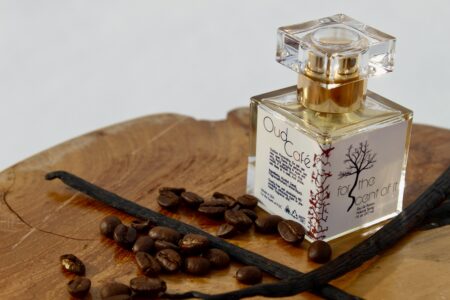
Thanks to Michael Schrammel we have a draw for a 30 ml of For The Scent Of It Oud Café for a registered user in the US only. To enter the draw, you must be a registered reader.
For the Scent of It Oud Café EDP Notes: Top: Espresso, White Pepper, Black Walnut, Bergamot. Heart: Oud, Coffee CO2, Iris, Bulgarian Rose, Oak. Base: Sandalwood, Labdanum Resinoid, Vetiver, Tonka Bean, Musk (For The Scent of It Oud Café was featured in Video Editor Steven Gavrielatos and Editor-in-Chief Michelyn Camen’s Best Winter Perfumes 2023)
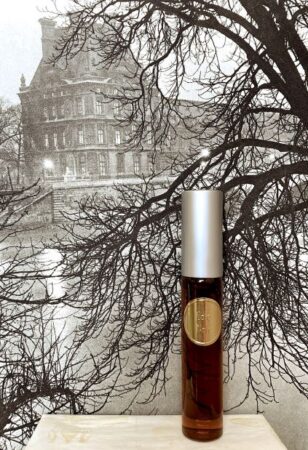
Thanks to Dawn Spencer Hurwitz of DSH Perfumes we have 10 ml pen of Café Noir which was launched in1997. Please read Ida’s review here It is a 96 percent Botanical perfume with notes of Bergamot, Black Pepper, Bulgarian Rose Otto, Cinnamon Bark, Coffee Absolute, Grandiflorum Jasmine, Labdanum
To be eligible, please leave a comment about what you learned about coffee in in general and about coffee in perfumery. You must register here. Please list the coffee perfumes you would like to win from the giveaway and that you are in the USA. Draw closes 2/1/2022. The winners will be announced within ten days after.
Follow us on Instagram at @cafleurebonofficial @elisepearlstine @forthescentofit @dshperfumes @fragrancesoftheworld
This is our Privacy and Draw Rules Policy
We announce the winners only on our site and on our Facebook page, so like Çafleurebon and use our blog feed…or your dream prize will be just spilled perfume.
